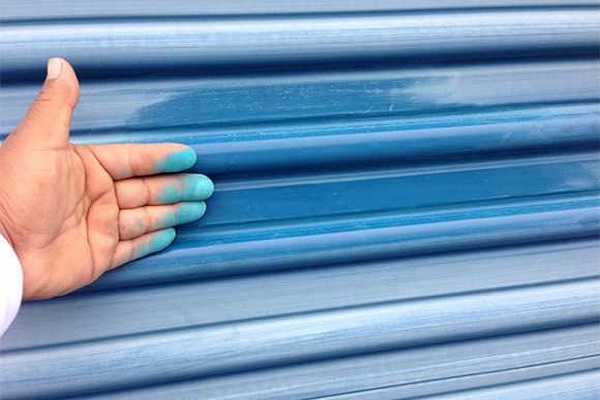Have you ever touched a wall, and your hand gets dirty with a powder? It is due to a paint defect called paint chalking. There are many reasons behind it.

You may have to face an embarrassing moment for the powdery substance on your walls in front of a guest. This article explains the paint chalking, its’ causes, identification, prevention, and correction methods.
Paint chalking is the formation of a very fine, light-colored, powdery residue on painted walls. It is observed on the walls exposed to the atmosphere, i.e., the exterior of the buildings.
Causes Of Paint Chalking
The primary reason for the paint chalking is the exposure of exterior walls to the sunlight. The paint is made up of binder and pigment. The UV rays in sunlight disintegrate the binder in the paint and separate the pigment from it.
The other reason for paint chalking is paint oxidation. It is a process of paint binder reacting with the oxygen in the atmosphere. The simultaneous occurrence of pigment separation and paint oxidation cause paint chalking.
As a result of above mentioned two processes, the paint sheen becomes progressively duller and the paint film thinner. The rain washes off the chalking paint; consequently, the paint gets thinner.
The paint chalking is severely affected by the paint’s quality. All paints chalk eventually; however, the cheaper paint is more likely to chalk sooner. The expensive paints have high-quality binders and pigments.
As binder and pigment are two main components of paint, it is necessary to have high-quality binders and pigments. Another factor that affects the chalking is the paint binder. Oil base paint oxidizes faster than most acrylic and latex paints.
Therefore, you should choose acrylic paint for exterior painting than oil-based paint. The best option is to choose 100% acrylic paint than paint with an acrylic and latex combination.
How To Identify Paint Chalking?
It is very easy to identify the paint chalking. There are two signs that signify it; the first one is the discoloration of the paint, and the second is forming a powdery substance on the painted surface.
How To Fix Chalky Residue?
1. First of all, find out the severity of chalking by rubbing the surface with a finger or a cloth.
2. Remove all chalk residue by pressure washing or sand-blasting for heavy chalking. Wash the wall with pressure water; you can also use a detergent/soap with a brush. Rinse the surface thoroughly.
2. For light chalking, use a wire brush or sanding to remove chalk. Then rinse the surface.
4. Recheck the surface using your finger or a rag to determine the amount of chalk residue. No priming is necessary if little or no chalk remains and the old paint is in good condition.
5. However, if light to moderate chalk remains, use a penetrating additive to the first coat of water-based paint so that the paint film bond with the chalked surface. 100% acrylic finish provides better chalk resistance than vinyl-acrylic paint.
6. If you still have noticeable chalk, use an alkyd-based masonry primer as the first coat of paint. Finish with a high-quality top coat.
Source: dailycivil










